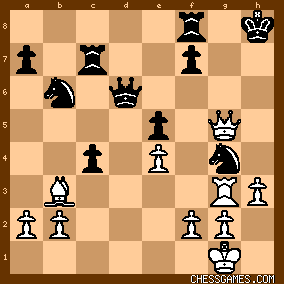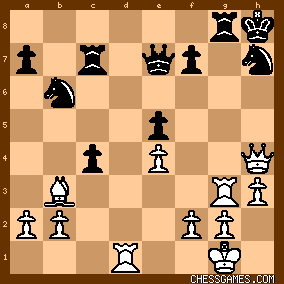|
< Earlier Kibitzing · PAGE 3 OF 3 ·
Later Kibitzing> |
| May-29-09 | | YouRang: But indeed, 25.Rd6!! is a lovely decoy rook sac that causes the Nf6 to be pinned, preventing the ...Nh7 defense that had foiled my efforts at solving this puzzle. And if the sac is not accepted, that rook becomes well placed to forcefully join the attack. Very nice puzzle. |
|
| May-29-09 | | kevin86: As has been the theme this week,the first move is a sharp sac-the real puzzler is the second move. Here,a very subtle pin and diversion move really stuns black. His seemingly stable position crumbles fast. |
|
| May-29-09 | | kevin86: The odder thing is the second pin after 26♖d6 ♕xd6 27 ♕g6+ ♔h8 28 ♕h6+ (and the knight cannot interpose as the queen would be lost) ♔g8 29 ♖g3# Pins here,pins there,everywhere pins. |
|
| May-29-09 | | lzromeu: I got this, the good and old bishop sacrifice in h6 square, but I miss something. I don't understand why 25rd6 was necessary. Someone help? |
|
| May-29-09 | | WhiteRook48: i didn't even get the bishop sac on h6 i picked Qh7+??? |
|
| May-29-09 | | Sydro: 25.Rd6 was a really sweet move. I did not see it though :( |
|
| May-29-09 | | bengalcat47: I hate to admit it, but at the point where Black resigned I'm having trouble finding White's best continuation if Black had played 28... Rg8. Any thoughts? |
|
| May-29-09 | | gofer: Hi <bengalcat47>
24 Bxh6 gxh6, 25 Rd6 Nbd7, 26 Qg6+ Kh8, 27 Qxh6+ Nh7, 28 Rg3 f6 (28 ... Rg8 fails to 29 Rxg8 Kxg8, 30 Rg6+ Kg8, 31 Qg7#) 29 Re6 Qf7 30 Rc6 Qd7 31 Rxc7 Rd8 32 Be6 and after 33 Rxd7 black cannot avoid either the rook on g3 mating on g8 or the queen mating on g7! |
|
| May-29-09 | | gofer: Hi <tatarch>. You are right. I think (now) that the best that white can hope for is 30 Rc6 winning the rook on c7 and keeping the pressure on the 7th rank. The win is not too far away after that, black now can't move the Knight and Be6 is starting to look like the last nail in black's coffin... :-)
24 Bxh6 gxh6, 25 Rd6 Nbd7, 26 Qg6+ Kh8, 27 Qxh6+ Nh7, 28 Rg3 f6 29 Re6 Qf7 30 Rc6 Qd7 31 Rxc7 Rd8 32 Be6 and after 33 Rxd7 black cannot avoid either the rook on g3 mating on g8 or the queen mating on g7! |
|
| May-29-09 | | JG27Pyth: Note to self... never ever complain about mid-week puzzles being "too easy" or "should have started a move earlier" ... because then CG gets revenge on you Friday, Saturday and Sunday! Ouch... like others, I'm having trouble even finding the finish from 28... |
|
May-29-09
 | | Jimfromprovidence: I can't see the 24...c4 25 Bxg7 line going anywhere. <gofer> <24... c4 fails to 25 Bxg7 (threatening Bxf6), so 25... Kxg7 26 Rd6. 26 ... Qxd6 fails to 27 Rg3+ Kh<8>, 28 Qg5 Rg8 29 Qh6+ winning the queen> If 26 ... Qxd6 27 Rg3+ Kh<8> 28 Qg5, now <Ng4!> 
click for larger viewAfter 29 Rxg4 f6 black is protected and winning.

click for larger view24...c4 still looks to be the best defense. |
|
| May-29-09 | | MiCrooks: Yeah, I jumped on Bxh6 with the immediate Qg6 neglecting to play that all the way through to its logical conclusion before peeking. When I saw Rd6 I thought cute but is it really necessary? Then when you get to the final position you realize that, yes, it is! Without the additional rook lift Black could defend with either Qf6 or perhaps even Rg8. Neither of these work with the Rook sitting on d6. The power of the Bishop's pin on f7 is wonderful and shows up again in the variation Rg8 Rxg8+ Kxg8 Rg6+ Kh8 Qg7++. |
|
| May-29-09 | | YouRang: <bengalcat47: I hate to admit it, but at the point where Black resigned I'm having trouble finding White's best continuation if Black had played 28... Rg8. Any thoughts?> Sure: 28...Rg8 29.Rxg8+ Kxg8 30.Rg6+ Kh8 31.Qg7# |
|
| May-29-09 | | YouRang: Oops - I see <gofer> already answered. :-\ |
|
| May-29-09 | | MiCrooks: The line after f6 is longer and not as easy to see. It too has been given already. As to c4 being the best defense...perhaps but you could just as easily resign. You will end up two pawns down in an inferior position after something like Rg3 g6 Bc2 Rfc8 Bg5 gxf5 Bxf6+ Kf8 Bxe7+ Kxe7 exf5. Obviously other lines are possible as well but basically you are dead lost whereas by taking the Bishop you can hope your opponent didn't have Rd6 in mind...if he did you lose but you were lost anyway. |
|
| May-29-09 | | DLev: After 24 ... c4, what is black's best defense to 25. Bxg7? The best outcome I could find (based on 25 ... Ne8, 26 Bxf8) leaves black down an exchange and pawns with an exposed King. 25 ... Kxg7 looks like mate after Rg3+ and Qg5. Black cannot allow Bxf6, so a Night move seems necessary. But that allows Bxf8 with more material advantage than in the Rybka line. I am not using an engine, so I know I must be missing something. What say the computers and better human analysts? |
|
| May-29-09 | | SpoiltVictorianChild: Missed it. Saw most of it, but didn't see Rd6 which prevents the defensive Qf6 |
|
| May-29-09 | | Marmot PFL: Deceptively easy. I didn't even consider 25 Rd6 but it has to be played. |
|
| May-29-09 | | lzromeu: I see it again. white 25rd6 has no defense for black and avoid 28...qf6 to final mate. Absolutely necessary. Antecipate 27...nh7 to move 25 avoid imediate checkmate with loss of material. |
|
May-29-09
 | | Jimfromprovidence: <DLev> <After 24 ... c4, what is black's best defense to 25. Bxg7? The best outcome I could find (based on 25 ... Ne8, 26 Bxf8) leaves black down an exchange and pawns with an exposed King. 25 ... Kxg7 looks like mate after Rg3+ and Qg5.> Black does have defensive resources on hand. If 24...c5 25 Bxg7 Kxg7 26 Rg3+ Kh8 27 Qg5, black has 27...Rg8.

click for larger view If white moves his queen to the h file black has Nh7 to block it. If, say, either 28 Qh6+ or 28 Qh4+ (below), then 28...Nh7. 
click for larger viewHere, both white's queen and bishop are en prise. |
|
| May-29-09 | | wals: Avigdor Bykhovsky - Oltean, 1990
Analysis by Rybka 3 1-cpu: Time 4 min 15 Ply 17
1.  (1.82): 24...c5-c4 25.Qf5-g5 Nf6-e8[] 26.Bb3-c2 f7-f6 27.Qg5-g4 Kg8-h8 28.Bh6-d2 Ne8-d6 29.Rc3-g3 Nd6-b7 30.f2-f4 Kh8-g8 31.f4xe5 f6xe5 32.Qg4-h5 Nb6-d7 33.Qh5-g5 Rf8-f6 34.Bd2-c3 Nb7-c5 35.Qg5-d2 Nc5-e6 (1.82): 24...c5-c4 25.Qf5-g5 Nf6-e8[] 26.Bb3-c2 f7-f6 27.Qg5-g4 Kg8-h8 28.Bh6-d2 Ne8-d6 29.Rc3-g3 Nd6-b7 30.f2-f4 Kh8-g8 31.f4xe5 f6xe5 32.Qg4-h5 Nb6-d7 33.Qh5-g5 Rf8-f6 34.Bd2-c3 Nb7-c5 35.Qg5-d2 Nc5-e6 2.  (2.29): 24...Kg8-h8 25.Bh6-g5 c5-c4 26.Rd1-c1 Rf8-c8 27.Bb3xc4 Rc7xc4 28.Rc3xc4 Rc8xc4 29.Rc1xc4 Nb6xc4 30.Qf5-c8+ Kh8-h7 31.Qc8xc4 Qe7-b7 32.Bg5xf6 g7xf6 33.b2-b4 Kh7-g7 34.b4-b5 Qb7-d7 35.Qc4-e2 Qd7-e7 36.Kg1-h2 Qe7-b4[] 37.g2-g3 Qb4-c5[] (2.29): 24...Kg8-h8 25.Bh6-g5 c5-c4 26.Rd1-c1 Rf8-c8 27.Bb3xc4 Rc7xc4 28.Rc3xc4 Rc8xc4 29.Rc1xc4 Nb6xc4 30.Qf5-c8+ Kh8-h7 31.Qc8xc4 Qe7-b7 32.Bg5xf6 g7xf6 33.b2-b4 Kh7-g7 34.b4-b5 Qb7-d7 35.Qc4-e2 Qd7-e7 36.Kg1-h2 Qe7-b4[] 37.g2-g3 Qb4-c5[] |
|
| May-29-09 | | CHESSTTCAMPS: Material is roughly even here, but white has a clear positional advantage with the two bishops and sounder pawn structure. Yet black has resources here: the pieces are fully developed, the knights are active, and black may be able to play a timely c4 to shut the LSB down. White needs to find the right plan. Candidate #1:
24.Bxh6
We are accustomed to look for forcing and sacrificial continuations, so I'm sure a lot of kibitzers examined this. However, white's h-pawn gets in the way of the attack; there isn't enough force to justify giving up the active bishop: 24...gxh6 (c4 25.Rg3 looks good for white) 25.Qg6+ Kh8 26.Qxh6+ Nh7 27.Rg3 f6 (Rg8 28.Rxg8+ Kxg8 29.Rd3 Kh8 30.Rg3 Qf6 seems OK too) 28.Bd5 (28.Qg6 c4 stifles white's attack) Nxd5 29.exd5 Rd7 30.d6 Qf7 and black withstands the attack with an extra piece in hand. Candidate #2:
24.Rdc1 is sound and may keep a small edge but doesn't look forcing enough. Black should be able to defend with Rfc8, but this is my fallback if I can't find something stronger in a reasonable amount of time Candidate #3:
24.f4
This seems to fit the positional requirements (with 2 bishops, try to open the game) and creates tactical opportunities. Possible continuations are: A. 24...g6? 25.Qxg6+ winning quickly
B. 24...Re8 25.fxe5 Nfd7 (Qxe5 26.Qxe5 Rxe5 27.Bf4) 26.Bxh6! c4 (gxh6? 27.Qg6+ forces a quick mate) 27.Rg3 g6 (cxb3 28.Rxg7+ forces mate) 28.e6! Kh8 29.Qf4 looks strong for white. C. 24...exf4 25.Bxc5 wins the exchange.
D. 24...Nfd7 25.fxe5 Nxe5 26.Bf4 Re8 (Nbd7 27.Rxd7) and white looks better, but I can't find anything decisive. Time to see what happened. |
|
May-29-09
 | | sbevan: <gofer: I have been looking at this and I think 24 Bxh6 gxh6
If black refuses the bishop then the white queen goes to g6 and then mates on g7 25 Rd6 is rather nice...
The black queen can't take the white rook because of the following combination... 26 ... Qxd6, 27 Qg6+ Kh8, 28 Qxh6+ Nh7, (28 ... Kg8, Rg6 mating) 29 Qxd6 winning the queen and the match. So now the Knight needs to move or get protected. 26 ... Nh7, 27 Rxh6 mating
26 ... Nbd5, 27 Bxd5 leaves white in the same predicament, but a piece further down. 26 ... Nbd7, 27 Qg6+ Kh8, 28 Qxh6+ Nh7, 29 Rg3 f6 (29 ... Rg8 fails to 30 Rxg8 Kxg8, 31 Rg6+ Kg8, 32 Qg7#) 30 Re6 Qf7 31 Re8 mating... the last part took me a long time to find, but it wasu there to find! :-)
Time to check>
Very nice analysis, thank you.
And I agree, I think Black did not see Rd6, nor for that matter did I.... |
|
| May-29-09 | | SamAtoms1980: Some complexities here. The first thing that came to my notice was 24 Bxh6 gxh6 25 Rg3+ or Qg6+ with an attack. Then I saw another option 24 Qg6, that uses two pins and threatens Bxh6 outright. With seemingly little to distinguish between these two good-looking moves, I finally did that which is unthinkable in the chessplayer's realm. I flipped a coin.
My token of choice was a pocket dime. Dimes are lucky, right? Heads, the pawn goes. The flip came up tails. Went with 24 Qg6. Looked, and it was 24 Bxh6. Aargh! Never mind that 24 Qg6 is jammed by 24 ... c4! and even if I had picked 24 Bxh6 I wouldn't have followed it up right anyway: 24 ... gxh6 25 Qg6+ Kh8 26 Qxh6+ Nh7 27 Rg3 Rg8, or 25 Rg3+ Kh8 stalls even sooner. 25 Rd6 was too deep for me. Easy Week? NOT!!!!! |
|
| Jun-01-09 | | patzer2: For the Friday, May 30, 2009 puzzle solution, the demolition 24. Bxh6!!, with the help of the decoy 25. Rd6! as noted by <YouRang>, opens up a winning attack on the weakened Black King side. In the final position if 24....f6, then 25. Rg3!  is the winning follow-up. is the winning follow-up. |
|
 |
 |
|
< Earlier Kibitzing · PAGE 3 OF 3 ·
Later Kibitzing> |





































